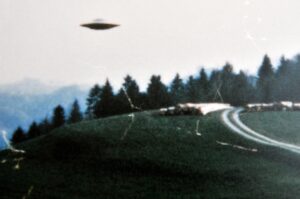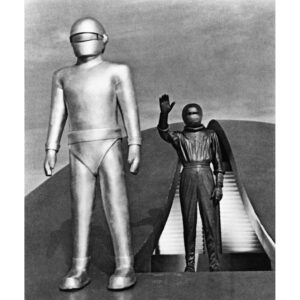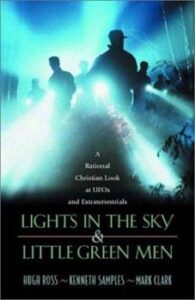Jan
29
The RUFO Phenomenon, Part 1 of 3
“You misunderstand me. I can only demonstrate that UFOs defy the laws of physics. That is not to say they cannot be real.” — Dr. Hugh Ross, in response to a challenge from a member of an audience of Russian scientists

As mentioned at the end of “When Is a UFO Not a UFO?, Part 2”, a small percentage of UFO sightings have proven resistant to prosaic, purely natural explanations. Even the experts disagree on some of them, but conservative estimates classify roughly 1-10% as “residual UFOs”, or RUFOs. In fact, here is a quick list of characteristics that increase the odds of an other-than-Earthly origin:
1) Anti-gravity lift.
2) Sudden and instantaneous acceleration.
3) Hypersonic velocities without signatures.
4) Low observability, or “cloaking”.
5) Trans-medium motion.
So, what are these RUFOs? Alien spacecraft? Aliens themselves? If so, what kind?
Some researchers and commentators insist that the objects are the result of natural phenomena and/or socio-psychological factors which have been misidentified and possibly not yet discovered. In other words, they will eventually be re-classified as debunked UFOs. But, as summarized by Kenneth Samples in Lights in the Sky and Little Green Men, critics of this position note that:
1) The presumption that all UFOs have natural explanations is a form of question-begging that may prejudice any honest attempt to get at the facts.
2) The argument that extraordinary claims require extraordinary evidence may itself be an unproven assumption.
3) Many UFO reports stubbornly resist a natural explanation even after being analyzed by competent and unbiased researchers.
4) Viewing all UFO reports as misidentified natural phenomena may be the simplest hypothesis, but does that hypothesis best account for the facts and avoid unwarranted presumptions?
Then, we need to ask:
1) Has an objective, logical, and scientific analysis been made of the best-evidenced UFO cases? If not, why not?
2) What type of evidence (kind, quantity, quality) would be required to substantiate the reality of UFOs, and how would one justify such evidentiary demands?

We still have the question, though, of what to do with the stubbornly inexplicable RUFOs. One of two alternative approaches are usually taken. The extraterrestrial hypothesis (ETH) maintains that the unidentified are “objective, physical, and empirical realities” — i.e., vehicles piloted by interplanetary space visitors. These visitors are from incredibly advanced civilizations who have apparently developed technologies unknown to us. It is generally assumed that such beings would be morally and spiritually superior, as well.
Samples provides a list of summarized objections leveled by critics of the ETH:
1) How are alien craft expected to traverse the vast distances of interstellar space, given the physical limits on how fast a craft can travel in space?
2) How can such a craft sustain a crew over these vast distances of space?
3) Why do sophisticated surveillance systems fail to detect incoming and outgoing UFOs?
4) How feasible is it for an extraterrestrial civilization, however advanced, to maintain a mission to Earth?
5) How is it possible that virtually every so-called metallic craft is different in size, shape, and color from the others?
6) Why are there so many different alien life forms, and how do they readily adapt to space travel and to Earth’s atmosphere and gravity?
7) Why do UFOs, as physical craft, not behave like physical objects but instead manipulate and violate the fundamental laws of physics at will?
8) What intelligent reason can be suggested for such bizarre and often absurd behavior as that exhibited by UFOs?
9) If alien visitors are physical, why do they so closely resemble or correspond to psychic or occultic phenomena?
10) As a proposed “advanced civilization” (in the areas of technology, morality, and spirituality), why do these aliens often comport themselves in a crude, sloppy, deceptive, and malevolent manner?

The interdimensional hypothesis (IDH) agrees that “some UFOs are real phenomena that may exhibit physical and empirical effects. But in this view the origin and nature of such phenomena belong not to extraterrestrial spacecraft but to another realm of reality beyond the time-space continuum. The IDH is thus sometimes described as the paranormal or occult view of UFOs.” Some ufologists (including Christians such as the authors of Lights in the Sky and Little Green Men) point to angelic or demonic causes, and even some leading secular ufologists (e.g., Jacques Vallée) see the parallels with occultic/demonic phenomena.
Samples also provides a list of summarized objections leveled by critics of the IDH:
1) What about the UFO reports that seem best interpreted as physical events, such as when UFOs appear on radar?
2) When some use the paranormal to explain UFOs, aren’t they making an appeal for one unverified phenomenon to explain another unverified phenomenon?
3) What evidence is there for the existence of the paranormal that is superior to the evidence for the physicality of UFOs?
4) Doesn’t the paranormal or occult hypothesis suffer from complexity, vagueness, and speculation?
5) Doesn’t the demonic theory depend on accepting a narrow Christian perspective?
Much of the aforementioned book is about addressing these questions and related issues in determining the strongest hypothesis. So, I won’t be getting into government conspiracies and cover-ups, for example, and I point you to other posts in which I addressed questions about life on other planets, interstellar space travel, etc. My focus in this blog series, as should be apparent, is specifically to inform readers about the characteristics and effects of RUFO events and the IDH explanation as presented by the book’s authors.
Stay tuned for Part 2 next week…















